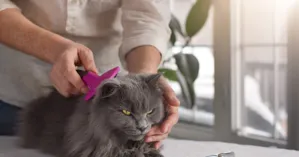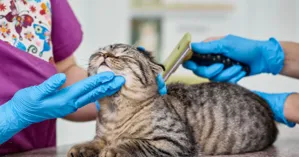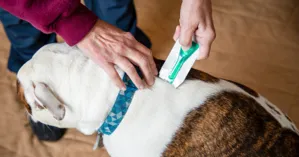- Quick Summary
- Setting Realistic Expectations
- Creating a Budget
- Sharing Carriers with Friends and Family
- Take Turns Dog Walking
- Skip Buying Expensive Toys
- Investing in Preventive Healthcare
- Purchase Pets from Reputable Breeders
- Brushing Pet Hair
- Preventing Periodontal Disease
- Learning to Groom
- Don’t Buy Medication from Veterinarians
- Buying Pet Food on a Budget
- Conclusion

- Quick Summary
- Setting Realistic Expectations
- Creating a Budget
- Sharing Carriers with Friends and Family
- Take Turns Dog Walking
- Skip Buying Expensive Toys
- Investing in Preventive Healthcare
- Purchase Pets from Reputable Breeders
- Brushing Pet Hair
- Preventing Periodontal Disease
- Learning to Groom
- Don’t Buy Medication from Veterinarians
- Buying Pet Food on a Budget
- Conclusion
About 66 percent of American households have a pet. Cats and dogs make up 197 million pets and they all must be cared for. Owning a pet is fulfilling but it’s also expensive if you do it right. We’ve found nine ways to save on pet care without compromising on budget friendly pet care.
1. Setting Realistic Expectations

Setting realistic expectations is crucial when it comes to pet care. As a responsible pet owner, it’s essential to understand that caring for a pet comes with financial responsibilities. Before bringing a new pet home, consider the costs associated with pet care, including food, vet bills, and supplies. Research the average cost of owning a pet in your area and factor that into your budget. By setting realistic expectations, you can ensure that you’re prepared to provide the best possible care for your pet without breaking the bank.
2. Creating a Budget

Creating a budget is a vital step in managing pet care costs. Start by tracking your income and expenses to understand where your money is going. Then, allocate a specific amount for pet care each month. Consider the costs of food, vet bills, supplies, and any other expenses associated with caring for your pet. Be sure to also factor in unexpected expenses, such as emergency vet visits. By creating a budget, you can ensure that you’re prioritizing your pet’s needs while also managing your finances effectively.
3. Sharing Carriers with Friends and Family

Why store a crate or carrier in the garage or attic? Go in with a friend or family member and by one. It’s not like all of you are using it at once, and it will save money without compromising your pet. This approach can be a smart addition to your pet care budget, helping you manage and reduce expenses effectively.
4. Take Turns Dog Walking

Do you have a dog walker come in mid-day to walk your dog. Could you go home at lunch and do it. Maybe share the duties with a friend or family member. If you can’t come home, ask family member to do it for you. Instead of paying them, go with the barter system. Do a task for them.
Additionally, consider including pet insurance as part of your budget to protect against unexpected veterinary expenses and reduce substantial out-of-pocket costs in case of accidents or illnesses.
5. Skip Buying Expensive Toys

Instead of buying expensive dog or cat toys, make them. Go online or on YouTube. You can make a chew toy for your dog with an old t-shirt. Or use an old tennis ball to play chase. Kitty would love a ping pong ball to chase around the house. Just make sure whatever you use doesn’t have small pieces that could be choking hazards.
6. Investing in Preventive Healthcare

Preventive healthcare can help you avoid expensive veterinary bills by practicing preventative care. It will lengthen your pet’s life and cost less in the long run. Ensure you give parasite protections to avoid pet bills. Take your pet to the vet as soon as you notice anything wrong to avoid the problem escalating.
7. Purchase Pets from Reputable Breeders

Free or discounted purebred puppies may seem like a good deal, but problems may be lurking. Puppy mills are known for inbreeding. This can result in many physical and behavioral problems. Reputable breeders charge more than pet stores, but you're assured of receiving a healthy dog. Purchasing a healthy dog saves vet bills and broken hearts.
8. Brushing Pet Hair

If your dog or cat has long fur, regular brushing is essential for maintaining your pet's health, whether it needs to be done daily or weekly to stay tangle-free. Pet groomers charge extra for removing mats and knots, which are preventable. It’s also more comfortable for the pet not to have clumps of fur all over its body. Be aware of areas around the cheeks and ears. These tend to mat more.
9. Preventing Periodontal Disease

A dog over three who has never had their teeth brushed is likely to have periodontal disease, which can impact their overall health and make it challenging to keep your pet healthy. If this happens to your pet it will require bloodwork and anesthesia to help it. That costs and is preventable. Instead of putting your pet and wallet through that, brush your pet’s teeth.
10. Learning to Groom

Professional grooming is expensive. And if you own a breed that needs regular de-furring, trimming and washing you’ll be in for hundreds or thousands of dollars. Instead, learn to clip and wash your dog. There are videos on YouTube that can help you, or get with your veterinarian and have them help you learn.
11. Don’t Buy Medication from Veterinarians

Instead of buying prescription drugs or food from your vet, shop around. Your vet can send the prescription to online retailers like Chewy. The medication is the same but costs a lot less.
12. Buying Pet Food on a Budget

Buying pet food on a budget requires some planning and research. Start by comparing prices at different pet stores and online retailers. Look for discounts, coupons, and promotions that can help you save money. Consider buying in bulk, but make sure to check the expiration dates and store the food properly to maintain freshness. You can also opt for generic or store-brand pet food, which is often cheaper than name-brand food. Additionally, consult with your vet to determine the best food for your pet’s specific needs and health conditions.
Conclusion
You don’t have to spend a fortune to have a pet. It may take a little planning, but your cat or dog can be happy and healthy without breaking the bank.



